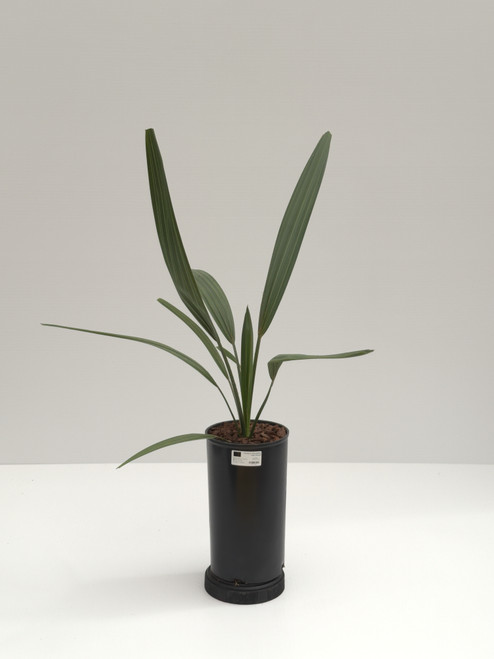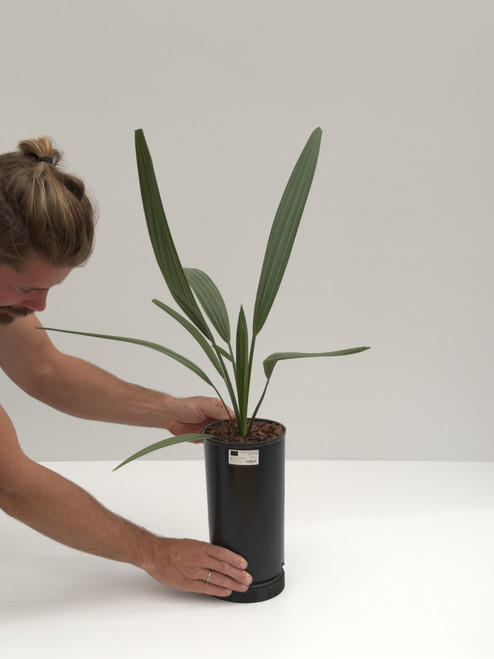Product Description
Habitat and distribution
Sabal palms are New World plants, this species is found in the Bahamas and Cuba, Florida, Georgia and the Carolinas. It thrives in a variety of settings including beaches, forests and swamps. In their natural range they are considered weedy as they readily propagate throughout the landscape, usually assisted by birds.
Description
Sabal palmetto, the cabbage palm, is a common inhabitant of scrub communities beyond sand dunes, and the state tree of Florida. It is recognized by its tan-gray, unbranched trunk, and large crown with fanlike leaves. S. palmetto grows to a height of 10 – 25 m (32-82 feet), with a stem diameter of approximately 30 – 60 cm (12-24 inches). (sms.si.edu)
A large robust palm with a solitary trunk, that grows to about 50 ft (15.2 m) but may occassionally reach heights of 70 ft (21.3 m). The crown is relatively small being 12-18 ft (3.7-5.5 m) in diameter. Like many palms the crown is typically wider when grown in shade and more compact when grown in full sun. The large leaves have a dull finish and are a medium green, sometimes yellow-green, in color depending on the individual and situation. Each leaf is up to 12 ft (3.7 m) long overall including the spineless petioles (leaf stems) which measure about 5-6 ft (1.5-1.8 m) in length. They are up to 6 ft (1.8 m) in width with drooping leaf segments about 3 ft (0.9 m) long and 2-3 in (5.1-7.6 cm) wide. These segments are split to about half the width of the leaf and typically slough off tan fibers at the edges. Cabbage palm leaves are costapalmate, meaning that the leaflets are arranged on the stem in a pattern that is midway between palmate (leaflets arranged like the fingers on the palm of your hand) and pinnate (feather shaped). (floridata.com) Editing by edric.
S. palmetto grows to a height of 10 – 25 m (32-82 feet), with a stem diameter of approximately 30 – 60 cm (12-24 inches). Leaves may measure up to 3 m (9.8 feet) in length. Fruits are small, measuring approximately 8 mm (1/3 inch) in width. Root systems are deeply penetrating, and may reach depths of 4.6 – 6.1 m (15-20 feet) (Duncan and Duncan 1988). Stem shape is uniform from the ground to the crown. Leaf bases, also known as boots, tend to slough off the tree as they dry, giving the trunk a smooth appearance (Duncan and Duncan 1988; Walker 1990). Leaves are palmate with no spines, and may measure 3 m (9.8 feet) in length, each with a prominent midrib. Flowers are cream colored and droop in clusters from the crown. Fruits are black and fleshy with a single seed (Olson et al. 1974). They may measure 8 mm (1/3 inch) in width. Root systems are short and bulbous, penetrating the soil to depths of 4.6 – 6.1 m (15-20 feet). (Smithsonian Marine Station at Ft. Pierce)
Culture
Optimum growth occurs in humid subtropical to warm temperate climates where average rainfall is 100 – 163 cm (39-64 inches), and average maximum/minimum temperatures range from –4 - 36° C (25-97 ° F). Northern growth is limited by low winter temperatures. (Smithsonian Marine Station at Ft. Pierce)
Preferred soil type for S. palmetto is calcium rich, and neutral to alkaline in nature. Cabbage palms prefer poorly drained soils, and often grow at the edge of freshwater and brackish wetlands. This species tolerates flooding (Alexander
Seed Germination: Sabal palm seeds are not difficult to germinate, but should be planted when fresh for best germination. With uniform moisture and high temperatures (86°F–95°F), germination can occur in as few as 18 days, with 50% of final germination occurring within 33 days (Carpenter 1987; Sento 1970). Newly emerged seedlings look much like grass, but each succeeding leaf has an additional leaf segment that adds to their width. The slow-growing seedlings can take 15–30 years to develop a visible trunk under natural conditions, but in nurseries this can occur much faster (McPherson and Williams 1996). Initial trunk elongation can be quite rapid under favorable conditions (up to 6 inches per year), but this quickly slows to less than an inch per year as the palm matures (McPherson and Williams 1996). (edis.ifas.ufl.edu)
Comments and Curiosities
This is a tillering palm, it exhibits saxophone style root growth (it has a heel), keep top third of heel above soil elevation!
Stem shape is uniform from the ground to the crown. Leaf bases, also known as boots, tend to slough off the tree as they dry, giving the trunk a smooth appearance (Duncan and Duncan 1988; Walker 1990). Leaves are palmate with no spines, and may measure 3 m (9.8 feet) in length, each with a prominent midrib. Flowers are cream colored and droop in clusters from the crown. Fruits are black and fleshy with a single seed (Olson et al. 1974). They may measure 8 mm (1/3 inch) in width. Root systems are short and bulbous, penetrating the soil to depths of 4.6 – 6.1 m (15-20 feet). (sms.si.edu)
S. palmetto grows to a height of 10 – 25 m (32-82 feet), with a stem diameter of approximately 30 – 60 cm (12-24 inches). Leaves may measure up to 3 m (9.8 feet) in length. Fruits are small, measuring approximately 8 mm (1/3 inch) in width. Root systems are deeply penetrating, and may reach depths of 4.6 – 6.1 m (15-20 feet). (sms.si.edu)























